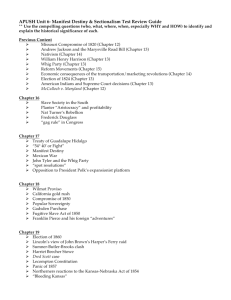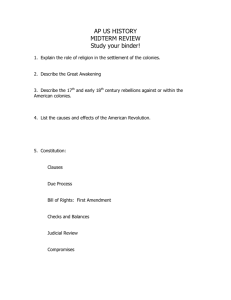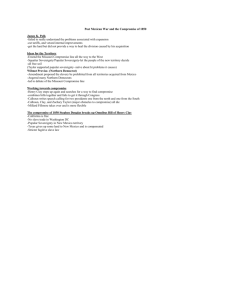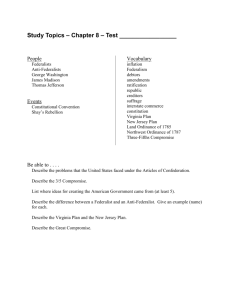LESSON 8
advertisement
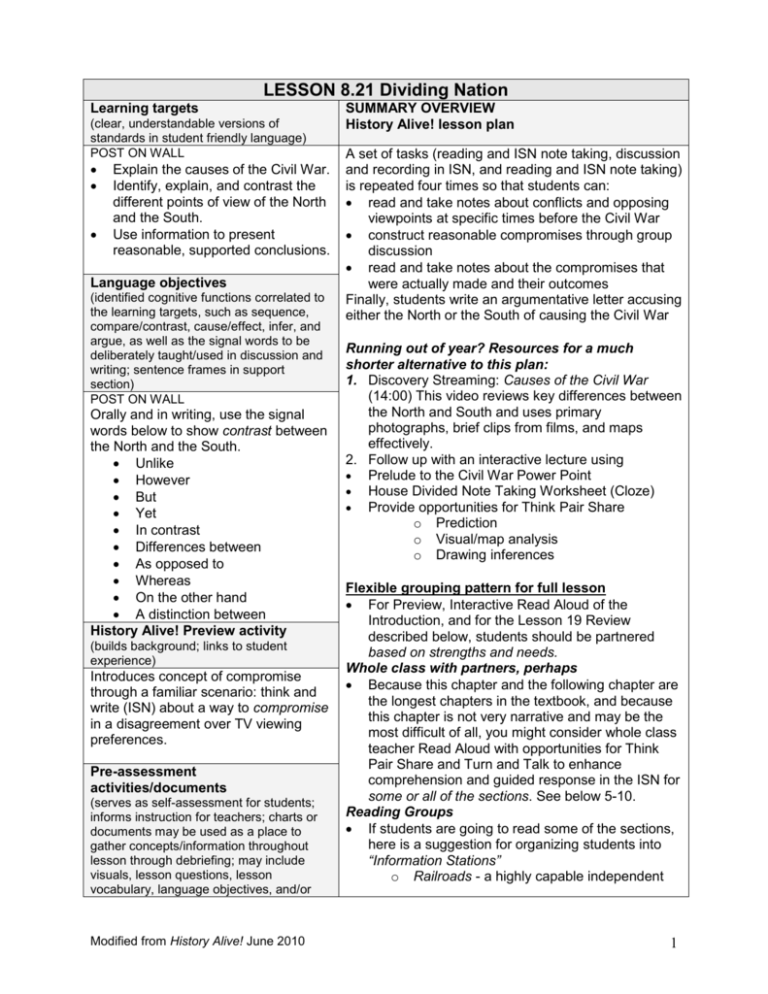
LESSON 8.21 Dividing Nation Learning targets (clear, understandable versions of standards in student friendly language) POST ON WALL Explain the causes of the Civil War. Identify, explain, and contrast the different points of view of the North and the South. Use information to present reasonable, supported conclusions. Language objectives (identified cognitive functions correlated to the learning targets, such as sequence, compare/contrast, cause/effect, infer, and argue, as well as the signal words to be deliberately taught/used in discussion and writing; sentence frames in support section) POST ON WALL Orally and in writing, use the signal words below to show contrast between the North and the South. Unlike However But Yet In contrast Differences between As opposed to Whereas On the other hand A distinction between History Alive! Preview activity (builds background; links to student experience) Introduces concept of compromise through a familiar scenario: think and write (ISN) about a way to compromise in a disagreement over TV viewing preferences. Pre-assessment activities/documents (serves as self-assessment for students; informs instruction for teachers; charts or documents may be used as a place to gather concepts/information throughout lesson through debriefing; may include visuals, lesson questions, lesson vocabulary, language objectives, and/or Modified from History Alive! June 2010 SUMMARY OVERVIEW History Alive! lesson plan A set of tasks (reading and ISN note taking, discussion and recording in ISN, and reading and ISN note taking) is repeated four times so that students can: read and take notes about conflicts and opposing viewpoints at specific times before the Civil War construct reasonable compromises through group discussion read and take notes about the compromises that were actually made and their outcomes Finally, students write an argumentative letter accusing either the North or the South of causing the Civil War Running out of year? Resources for a much shorter alternative to this plan: 1. Discovery Streaming: Causes of the Civil War (14:00) This video reviews key differences between the North and South and uses primary photographs, brief clips from films, and maps effectively. 2. Follow up with an interactive lecture using Prelude to the Civil War Power Point House Divided Note Taking Worksheet (Cloze) Provide opportunities for Think Pair Share o Prediction o Visual/map analysis o Drawing inferences Flexible grouping pattern for full lesson For Preview, Interactive Read Aloud of the Introduction, and for the Lesson 19 Review described below, students should be partnered based on strengths and needs. Whole class with partners, perhaps Because this chapter and the following chapter are the longest chapters in the textbook, and because this chapter is not very narrative and may be the most difficult of all, you might consider whole class teacher Read Aloud with opportunities for Think Pair Share and Turn and Talk to enhance comprehension and guided response in the ISN for some or all of the sections. See below 5-10. Reading Groups If students are going to read some of the sections, here is a suggestion for organizing students into “Information Stations” o Railroads - a highly capable independent 1 learning targets) reading group o Clipper Ships - a group of partners – meets Knowledge Rating Chart_8.6.21 OR and nearly meets - for Whisper Read Carousel (useful for adding new knowledge Alternative Paragraphs with Paraphrasing during the lesson) o Steamboats - a teacher guided group Student directions: Write to show what you Discussion Groups know. Use sticky notes; write your initials on For discussion sections of the lesson, students the back. should move back to heterogeneous groups of four – Scaffolds: Partnering based on strengths “Compromise Stations.” and needs; students may illustrate thinking; B Beg level LLs may write in native language After discussion and writing up of the compromise, students move back into Information Stations Map of US with free and slave states marked and T chart underneath. If you have a group of highly capable readers, allow Prompt: List issues that divided the them to continue together during discussion and to North and the South prior to the Civil take the test (pass at 80%) when they are ready; War. then provide the Enrichment prompt and additional Map of Missouri Compromise and T chart resources for the argumentative writing assignment. Prompt: what did each (N and S) Recommended changes to HA! lesson plan give up in this compromise? 1. Beginning language learners could act out a Map of Compromise of 1850 and T chart compromise with a partner using Sentence Frames Prompt: what did each (N and S) (see Writing Support below) and then copy them into in give up in this compromise? the ISN. Map of Kansas Nebraska Act and T chart 2. Follow the preview with a vocabulary introduction to Prompt: what did each (N and S) give up with this act? the word compromise (a key concept of the lesson), Copied textbook images of: focusing on word parts and cognates, Online “Fugitive Slave Law” instructional video uses this word as example: Underground Railroad http://www.pps.k12.or.us/departments/curriculum/3389.htm Uncle Tom’s Cabin 3. Review Lesson 19 because of the time interval for slave market teaching chapter 20 and because chapter 21 builds Dred Scott on contrasts between North and South learned in Lincoln Douglas Debate chapter 19. The brief review suggested below would Beating in Senate also provide an opportunity to use contrast words Lesson questions (drive instruction; may create links to previous learning; may be included in preassessment) POST ON WALL Was the North or the South responsible for the Civil War? What might make compromise difficult? Could the Civil War have been avoided? If so how? If not, why not? Additional background building (streaming video segments, DVD, map review, read aloud of a related piece of fiction, etc.) Causes of the Civil War (14:00) streams or downloads from Discovery Streaming. Excellent for preview and review. All the key points are mentioned. Divided into Modified from History Alive! June 2010 that will be needed during other parts of the lesson. (See video Teaching Compare and Contrast that uses this lesson as the example http://www.pps.k12.or.us/departments/curriculum/3389.htm) Post Lesson 19 T-chart: see attached Lesson 21 Power Point, slide 1 Post Contrast Signal Words (see Language Objectives) Post Sentence Frames (see Discussion Support below) Students take turns (N, then S) in pairs to complete the sentence frames using the Tchart information and contrast words. Challenge grade level speakers to use more sophisticated word choice and sentence structures. 4. It would also be a good idea to have students put different colored removable sticky dots on the slave and free states on the Interactive Desk Map using 2 segments nine segments, so you can easily repeat parts. No separate quiz necessary because this completely dovetails with History Alive! Key content vocabulary (italicized words assessed) You may wish to follow the preview with a vocabulary introduction to the word compromise, one of the key concepts of the lesson. Online video uses this word as example http://www.pps.k12.or.us/departments/curri culum/3389.htm compromise Missouri Compromise Compromise of 1850 Fugitive Slave Law Kansas-Nebraska Act Mexican Cession and Wilmot Proviso Dred Scott decision Nationalism and sectionalism 5. 6. 7. 8. 9. Transparency 21 B to guide them. You can guide students to add dots as you work through the admission of states. You can also use some sort of temporary markers on the black line wall map of the US. Reasons for teacher Read Aloud are mentioned in the Flexible Grouping section. If you are going to do some Read Aloud and some grouping, it would probably be best to do the teacher Read Aloud at the beginning of the chapter. That has worked well for some of us. Seat students in Compromise groups (heterogeneous with partnering based on strengths and needs). Have students Turn and Talk to predict what would happen if another state wanted to join the union Read Aloud 21.2 and guide students to complete Part 1 of the reading notes. In Compromise groups of four, one pair of partners will be Northerners and one pair of partners will be Southerners. Choose partners based on strengths and needs; choose N or S randomly. Pinky holding during compromise is not necessary and in some cases, not advisable Instead of having all Northerners and Southerners gather on separate sides of the room to plan for the compromise discussion, just let partners at the tables whisper quietly to prepare. (see below) After students write down their compromises, have students study the map on page 288 and ask Which state was admitted as a free state? Which state was admitted as a slave state? Then Read Aloud Section 21.3 and guide students to record the provisions of the Missouri Compromise in Part 3 of their Reading Notes. You can review each section using the attached Lesson 8.21 Power Point 10. You can either use the Information Station suggestion in the Flexible Grouping section or follow the same teacher led process with the next section: Examine transparency and Teacher Read Aloud and guided note-taking of Part 1 Compromise group discussion and recording of compromise in Part 2 Examine map and Teacher Read Aloud of and guided completion of notes about the Modified from History Alive! June 2010 3 compromise in Part 3. 11. During the reading of the third section, when Uncle Tom’s Cabin is introduced, you may wish to do a brief Guided Reading lesson with the passage in the Assessment that is from the novel. (This really should not be part of the content assessment.) 12. An expanded Processing Assignment provides an excellent opportunity for argumentative writing (common assignment) and better assessment preparation. Included with this document are several levels of scaffolding: Revised prompt/instruction sheet Graphic organizer with Main Idea and Detail sections and Transition Words Graphic organizer with Sentence Starters Graphic organizer for a single paragraph READING SUPPORTS Lesson-specific instructional supports http://groups.teachtci.com/ * see Enrichment Plan for Compacting/Extensions Suggested strategies for Focus Thinking or introduction pages/paragraphs for Process-Related Words Interactive Read-Aloud guided reading group (for example, Bloom’s etc.) Chapter image questions for Think Pair Share What do you see? What do you think is going on? After first paragraph: Think Pair Share Why did slavery continue for so long? (Southern economy, cotton gin; some Northerner slave traders also benefitted; racism) Visual Metaphor What do you see? What does the metaphor mean? Modified from History Alive! June 2010 Teacher guided small group (Steamboats): for most sections of this chapter, you could show and tell/summarize and read some sections aloud, and use the Power Point for note taking points. Key passages for guided reading: Missouri Compromise - p. 286 chart and Questions about Missouri - p.288 map and A Compromise is Reached Compromise of 1850 - p. 290 visual, Slavery in the Territories and the first paragraph of Statehood for California. - Read aloud the whole section on p. 291 The Compromise is Accepted, and use the map. Contrast Cause Identify Argument Refute/rebut 4 Fugitive Slave Law - Read Aloud the whole section on p. 292 Uncle Tom’s Cabin - p. 292 paragraph at bottom (just tell them about the rest) also, do a brief Guided Reading lesson with the passage in the Assessment that is from the novel with the whole class. Ostend Manifesto, Kansas-Nebraska, and the Violence in Congress several pages of show and tell - p.294 map - p.295 picture - p.296 picture Dred Scott Decision - p. 296 first paragraph of The Dred Scott Case - p. 297 first two paragraphs of Two Judicial Bombshells and explain the rest using the map to show the enormity of the impact of the decision Show and tell the senate race Lincoln Douglas Debates except - p.298 the fourth paragraph on the page Then explain why the Presidential election outcome was so important. You might consider reading aloud the whole last section on Secession. WRITING SUPPORT Lesson-specific instructional supports http://groups.teachtci.com/ * see Enrichment Plan for Compacting/Extensions Sentence frames for parts of the lesson Modified from History Alive! June 2010 5 During Preview, beginning Language Learners can use Sentence Frames with a partner before writing them in ISN. - I want to watch _A_, but you want to watch _B_. - We can compromise. - We can watch _A_ for half an hour and watch _B_ for half an hour. DISCUSSION SUPPORT Lesson-specific instructional supports http://groups.teachtci.com/ * see Enrichment Plan for Compacting/Extensions Sentence frames for parts of the lesson Lesson 19 Review Sentence Frames - The North has ______, but the South has __________. - In the North there are __________. However, in the South there are _____. - A difference between the North and the South is that the North has _____, but the South has _______. FORMATIVE ASSESSMENTS (for student and teacher use) “Check for understanding” Checkpoints in Student Questions for points during activities Interactive Notebook exit and entrance slips Make observations during carousel and Lesson 19 review activities. Listen in during compromise discussions for misconceptions. After each Part 1 you could debrief with the whole class. After 21.3 What three things happened as a result of the Missouri Compromise? After 21.5 What three four things happened as a result of the Compromise of 1850? After 21.7 What did the Dred Scott Decision say about citizenship for African Americans? How did the South feel about the Missouri Modified from History Alive! June 2010 6 Compromise and why? After 21.8 or 21.9 Describe the positions that Lincoln and Douglas each expressed about slavery during their senate race debates. Processing Assignment REVIEW Games Other (also serves as a formative assessment) Write a letter as a Northerner or a Southerner, accusing the other side of causing the Civil War. Then exchange letters with someone who has written from the opposing position; after reading the letter, write a rebuttal to that position in the concluding paragraph of the letter. This would make an excellent argumentative essay assignment. Jeopardy Questions Category: Slave or Free? (lower points) Free state that balanced a new slave state in the Missouri Compromise (Maine) Free state that had been part of Mexican land (California) The bloody territory that was to choose to have slavery or not (Kansas-Nebraska) Category: 3 Details About… (high points) Missouri Compromise Compromise of 1850 Kansas-Nebraska Act Dred Scott Decision Category: Who Was That? (highest points) Wrote the amendment to Missouri’s application for statehood (Tallmadge) Proposed that no one would be born into slavery after 1845 (John Quincy Adams) Led a slave rebellion (Nat Turner) Modified from History Alive! June 2010 7 Wrote both the Missouri Compromise and the Compromise of 1850 (Henry Clay) Wrote that no land taken from Mexico should become slave states. (Wilmot) Debated with Lincoln when they were both running for senator from Illinois (Douglas) Raided Harper’s Ferry, for weapons to arm slaves (John Brown) RECOMMENDED LESSON ASSESSMENT AND KEY Assessment Key Modified from History Alive! June 2010 8

